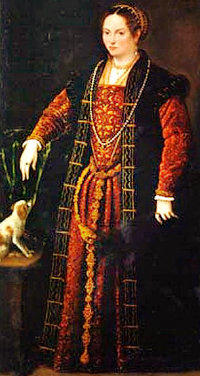The History of Art And The Curious Lives of Famous Painters
|
||||
|
Biography Domenico Brusasorci or Domenico Ricci (he is known by both names) was among the great masters of the Renaissance. He traveled intermittently in and around Verona, Vicenza and Rome, securing religious commissions as he went along. His work primarily focused on biblical themes that affirm religious doctrine advocated by the Catholic church. He worked primarily painting altarpieces and fresco for local chapels. In terms of style, Brusasorci moved away from High Renaissance artists such as Michelangelo or Raphael toward a more flamboyant and emotionally experimental style. Brusasorci's mannerist style is characterized by elongated limbs, thin aquiline noses, overly stylized figures, undersized heads, electrifying, vibrant colors and elaborately mannered, theatrical compositions. Mannerism is an artistic style that surfaced after the Sack of Rome on May 6 1527, when Charles V, Holy Roman Emperor, descended upon Rome looting, plundering and massacring. Many great artworks were destroyed or carted off. The term mannerism comes from the Italian maniera, which translates to 'style. This senseless slaughter unhinged Renaissance confidence, humanism and their way of thinking to the core.
|
||||
|
About The High Renaissance Period There is a spirit of general growth and enlightenment Artists of the Renaissance were elevated in social standing and their art was no longer looked upon as simple handicrafts, but as divinely inspired creations. Michelangelo asserted "Many believe - and I believe - that I have been designated for this work by God. In spite of my old age, I do not want to give it up; I work out of love for God and I put all my hope in Him." The spirit of an era awoke, revitalized with knowledge and creativity. Although art still served a specific functions, which were primarily religious, painters added more of their individual spirit and personal vision to their creations. John Ruskin, famous art historian stated, "The art of any country is the exponent of its social and political virtues . The art, or general productive and formative energy, of any country, is an exact exponent of its ethical life. you can have noble art only from noble persons, associated under laws fitted to their time and circumstance." ' The major painters of the Renaissance were not only artists but men of great genius who gave the world their great intellectual gifts. Author and art historian, John C. Van Dyke asserts "The Italian civilization of the fourteenth century was made up of many impulses and inclinations, none of them very strongly defined. There was a feeling about in the dark, a groping toward the light, but the lead[59]ers stumbled often on the road. There was good reason for it. The knowledge of the ancient world lay buried under the ruins of Rome. The Italians had to learn it all over again, almost without a precedent, almost without a preceptor. With the fifteenth century the horizon began to brighten. The Early Renaissance was begun. It was not a revolt, a reaction, or a starting out on a new path. It was a development of the Gothic period; and the three inclinations of the Gothic period—religion, the desire for classic knowledge, and the study of nature—were carried into the art of the time with greater realization. Florentine and Venetian painting were both formed by extraordinary personalities. These independent creative geniuses tackled mathematical, artistic and philosophical problems of the highest interest, and presented solutions that have never lost their value. The greatest Renaissance master, Leonardo da Vinci declared "You will never have a greater or lesser dominion than that over yourself. . . . the height of a man's success is gauged by his self-mastery; the depth of his failure by his self-abandonment. . . . And this law is the expression of eternal justice. He who cannot establish dominion over himself will have no dominion over others." The sense of humanism pervading renaissance painting is still palpable. The painters touched on a multitude of issues regarding the human condition - death, love, reason, religion, universal morality, social problems. |
||||
Key Descriptive Words and Phrases associated with the Renaissance Movement - rebirth, rediscovery of the classical world, publication of Della Pittura, a book about the laws of mathematical perspective for artists, sfumato, chiaroscuro, Savonarola, spiritually significant, illuminated manuscript, idealized biblical themes, scriptorium, illuminator, Age of Discovery, axonometric drawing, curiosity about the natural world, realistic use of colours and light, Bonfire of the Vanities, Old Testament stories, ethereal and foggy backgrounds, Gospel parables, The Blackdeath, romanticized landscapes, Christian symbolism. Require more facts and information about Domenico Brusasorci and the artists of the renaissance era? Poke around every nook and cranny of the known universe for information this subject. Search Here © HistoryofPainters.com If you like this page and wish to share it, you are welcome to link to it, with our thanks.
If you feel you have worthwhile information you would like to contribute we would love to hear from you. We collect essential biographical information and artist quotes from folks all over the globe and appreciate your participation. When submitting please, if possible, site the source and provide English translation. Email to millardmulch@gmail.com |
